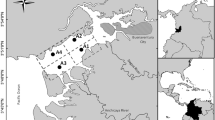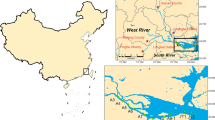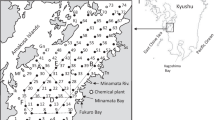Abstract
The release of mercury from intertidal sediment to atmosphere was studied based on the simulated experiment. The experiment samples were collected from the Haibo Estuary (S1) and the Licun Estuary (S2) of the Jiaozhou Bay in China, which are seriously polluted with mercury. The results show that the mercury in sediment releases rapidly to atmosphere under solar radiation. After 8 hours of solar radiation, mercury concentrations decrease from 5.62 μg/g and 2.92 μg/g to 2.34 μg/g and 1.39 μg/g in S1 and S2 sediments respectively in summer, and decrease from 5.62 μg/g and 2.92 μg/g to 4.58 μg/g and 2.13 μg/g respectively in winter. The mercury species in the sediment change markedly under solar radiation. The concentrations of mercury bound to organic matter decrease significantly from 2.73 μg/g to 0.31 μg/g in S1 and from 2.07 μg/g to 0.31 μg/g in S2, and the released mercury mainly comes from mercury bound to organic matter. Mercury flux shows distinguishing characteristic of diurnal change, and it increases rapidly in the morning with the rising of solar radiation intensity, but decreases in the afternoon. The mercury flux increases with sediment temperature and solar radiation intensity. The rapid release of mercury in intertidal sediment plays an important role in the regional mercury cycle.
Similar content being viewed by others
References
Alberts J J, Schindler J E, Miller R W, 1974. Elemental mercury evolution mediated by humic acid. Science, 184(4139): 895–897. DOI: 10.1126/science.184.4139.895
Bergan T, Gallardo L, Rodhe H, 1999. Mercury in the global troposphere: A three-dimensional model study. Atmospheric Environment, 33(10): 1575–1585. DOI: 10.1016/S1352-2310(98)-00370-7
Canario J, Vale C, 2004. Rapid release of mercury from intertidal sediment exposed to solar radiation: A field experiment. Environmental Science & Technology, 38(14): 3901–3907. DOI: 10.1021/es035429f
Carpi A, Lindberg S E, 1998. Application of a teflon dynamic flux chamber for quantifying soil mercury flux: Tests and results over background soil. Atmospheric Environment, 32(5): 873–882. DOI: 10.1016/S1352-2310(97)00133-7
Costa M, Liss P S, 1999. Photoreduction of mercury in sea water and its possible implication for Hg0 air-sea fluxes. Marine Chemistry, 68(1): 87–95. DOI: 10.1016/S0304-4203(99)000675
Costa M, Liss P S, 2000. Photoreduction and evolution of mercury from seawater. The Science of the Environment, 261(1): 125–135.
Engle M A, Gustin M S, Johnson D W et al., 2006. Mercury distribution in two Sierran forest and one desert sagebrush steppe ecosystem and the effects on fire. The Science of the Total Environment, 367(1): 222–233. DOI: 10.1016/j.scitotenv.2005.11.025
Gardfeldt K, Feng X, Sommar J et al., 2001. Total gaseous mercury exchange between air and water at river and sea surfaces in Swedish coastal regions. Atmospheric Environment, 35(17): 3027–3038. DOI: 10.1016/S1352-2310(01)00560-X
Gustin M S, Lindberg S, Marsik G et al., 1999. Nevada STORMS project: Measurement of mercury emissions from naturally enriched surfaces. Journal of Geophysical Research, 104: 21831–21844.
Gustin M S, Biester H, Kim C S, 2002. Investigation of the light-enhanced emission of mercury from naturally enriched substrates. Atmospheric Environment, 36(20): 3241–3254. DOI: 10.1016/S1352-2310(02)00329-1
Horne P A, Williams P T, 1996. Sampling and analysis of mercury species in effluent gases derived from waste incineration. Waste Management, 16(7): 579–586. DOI: 10.1016/S0956-053X(96)-00104-3
Kim K, Lindberg S E, Meyers T P, 1995. Micrometeorological measurements of mercury vapor fluxes over background forest soils in eastern Tennessee. Atmospheric Environment, 29(2): 267–282. DOI: 10.1016/1352-2310(94)00198-T
Kuiken T, Zhang H, Gustin M et al., 2008. Mercury emission from terrestrial background surfaces in the eastern USA. Part I: Air/surface exchange of mercury within a southeastern deciduous forest (Tennessee) over one year. Applied Geochemistry, 23(3): 345–355. DOI:10.1016/j.apgeochem.2007.12.006
Lindberg S E, Dong W, Meyers T, 2002. Transpiration of gaseous elemental mercury through vegetation in a subtropical wetland in Florida. Atmospheric Environment, 36(33): 5207–5219. DOI: 10.1016/S1352-2310(02)00586-1
Mason R P, Fitzgerald W F, Morel F M M, 1994. The biogeochemical cycling of elemental Mercury: Anthropogenic influences. Geochimica et Cosmochimica Acta, 58(15): 3191–3198.
Mason R P, Lawson N M, Sheu G R, 2001. Mercury in the Atlantic Ocean: Factors controlling air-sea exchange of mercury and its distribution in the upper waters. Deep-Sea Research II, 48(13): 2829–2853.
Nriagu J O, 1994. Mechanistic steps in the photoreduction of mercury in natural waters. The Science of the Total Environment, 154(1): 1–8. DOI: 10.1016/0048-9697(94)90608-4
Nriagu J, Becker C, 2003. Volcanic emissions of mercury to the atmospheric: Global and regional inventories. The Science of the Total Environment, 304(1): 3–12. DOI: 10.1016/j.scitoten-v.2003.09.027
Pang S W, Qiu G K, Sun J F, 1981. Determine the species of mercury using the method of sequential extraction. Acta Scientiae Circumstantiae, 1(3): 234–241. (in Chinese)
Poissant L, Casimir A, 1998. Water-air and soil-air exchange rate of total gaseous mercury measured at background sites. Atmospheric Environment, 32(5): 883–893. DOI: 10.1016/S13-52-2310(97)00132-5
Rasmussen P E, Mierle G, Nriagu J O, 1991. The analysis of vegetation for total Hg. Water, Air and Soil Pollution, 56: 379–390.
Schroeder W, Munthe J, 1998. Atmospheric mercury—An overview. Atmospheric Environment, 32(5): 809–822. DOI: 10.10-16/S1352-2310(97)00293-8
Skogerboe R K, Wilson S A, 1981. Reduction of ionic species by fulvic acid. Analytical Chemistry, 53: 228–232.
Slemr F, Langer E, 1992. Increase in global atmospheric concentrations of mercury inferred from measurements over the Atlantic Ocean. Nature, 355: 434–437. DOI: 10.1038/3554340.0
Temme C, Slemr F, Ebinghaus R et al., 2003. Distribution of mercury over the Atlantic Ocean in 1996 and 1999–2001. Atmospheric Environment, 37(14): 1889–1897. DOI: 10.1016/-S1-352-2310(03)00069-4
Tessler A, Campbell P G C, Bisson M, 1979. Sequential extraction procedure for the speciation of particulate trace metals. Analytical Chemistry, 51(7): 844–851.
United Nations Environment Programme (UNEP), 2002. Global Mercury Assessment. Geneva: UNEP Chemicals.
Wang Q, Shen W, Ma Z et al., 2000. Estimation of mercury emission from coal combustion in China. Environmental Science & Technology, 34(13): 2711–2713. DOI: 10.1021/es-990774j
Wang S F, Feng X B, Qiu G L et al., 2004. Contrast of Hg flux of soil/air in cold and warm season in Hongfeng Lake in Guizhou. Environmental Science, 25(1):124–127. (in Chinese)
Xiao Z F, Stromberg D, Lindqvist O, 1995. Influence of humic substances on photolysis of divalent mercury in aqueous solution. Water, Air and Soil Pollution, 80: 789–798.
Author information
Authors and Affiliations
Corresponding author
Additional information
Foundation item: Under the auspices of National Natural Science Foundation of China (No. 40806045), the Program of the State Bureau of Oceanic Administration (No. 908-02-02-03)
Rights and permissions
About this article
Cite this article
Liu, R., Wang, Y., Shan, C. et al. Release of mercury from intertidal sediment to atmosphere in summer and winter. Chin. Geogr. Sci. 20, 99–105 (2010). https://doi.org/10.1007/s11769-010-0099-8
Received:
Accepted:
Published:
Issue Date:
DOI: https://doi.org/10.1007/s11769-010-0099-8




